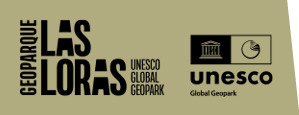Welcome to Las Loras Geopark
Las Loras Geopark is located in the north of Castile and León, halfway between Palencia and Burgos connecting the mountains and the tertiary river basin in Castile.
According to UNESCO (1999) a Geopark is a territory with one or more sites of scientific importance, not only because of its geology but also for its archaeological, ecological and cultural values.
The landscape you are looking at is the outcome of several geological events and transformations suffered by this territory over the last 250 million years (Myr). This stunning geological history is shown by the study of the characteristics of the different types of rocks (fossils, internal structures, etc).
Las Loras Geopark was part of a seabed from the 200 Myr to the 145 Myr (Early and Middle Jurassic). This fact is confirmed by the Jurassic rocks found all around the territory with several fossil remains of marine origin, such as ammonites, sponges, bivalves and other.
A very important event occurred after the 145 Myr (Upper Jurassic): the separation of Iberia from the European Plate (Euroasian) because of a continental fracture, which caused the opening of the Gulf of Biscay. This gave rise to a lifting of all Jurassic material, and the bottom of the sea was then exposed. Rivers started flowing and leaving their tracks in the shape of sandy sediments. The sandstones of San Martin cave church are a good example of material deposited at that time. The total separation of Iberia occurred in the 110 Myr (Early Cretaceous) and it became the Iberian Microplate.
From that moment until the 89 Myr (Upper Cretaceous) a new geological event, which was extremely important for the formation of Las Loras, began. The sea started invading most of the continent, burying sandy material deposited during the Early Cretaceous. The limestone and marl that make part of Las Loras, and in which several marine fossils such as bivalves, rudists, corals, ostreida and other can be found, belong to this period.
That is when one of the globally most important events began to occur: the collision between the Iberian Plate and the European one and its union. This collision caused great folds and huge fractures, which gave rise to the emersion of the sediments deposited at the bottom of the ocean in the shape of mountain ranges. The Pyrenees and the most eastern part of the Cantabrian Mountain Range are the outcome of that collision and the reason why all that marine fossils appear at Las Loras.
Once all the rocks emerge and start becoming part of the Iberian Peninsula, the contemporary appearance of Las Loras starts taking shape. All that folded and fractured material, already emerged, started being attacked by the different erosion processes like wind, rain and rivers. Limestone is the most resistant and is therefore found at the highest areas of Las Loras, while sandstone and marl lie in the valleys.
More interesting information and curious facts:
We shouldn’t forget that the existence of a type of substratum or a type of soil influences the development of different plant species, which are also quite influenced by weather conditions in that site. Therefore, oaks and beech trees can be found on the north-facing hillsides and Holm and Lusitanian oaks on the south-facing ones. Hazelnut trees and white hellebores grow on the protected dolines and heather and common junipers develop on more exposed surfaces.
Fauna is rich in species in this sparsely populated territory where we can find foxes, wild boars, roe deer and wolves, a wide variety of reptiles, protected species such as the badger, the ferret and the wildcat.
The great variety of avifauna is also notable and it is mainly composed of prey birds such as the vulture, the eagle owl, the peregrine falcon, the golden eagle and the Egyptian vulture, among others.
Las Loras territory has been used by the man throughout time as shown by the example of the hermitage of San Martín at the bottom of Monte Bernorio and excavated in sandstone, in the same way as other hermitages inside Las Loras, such as Olleros de Pisuerga and San Pelayo.
